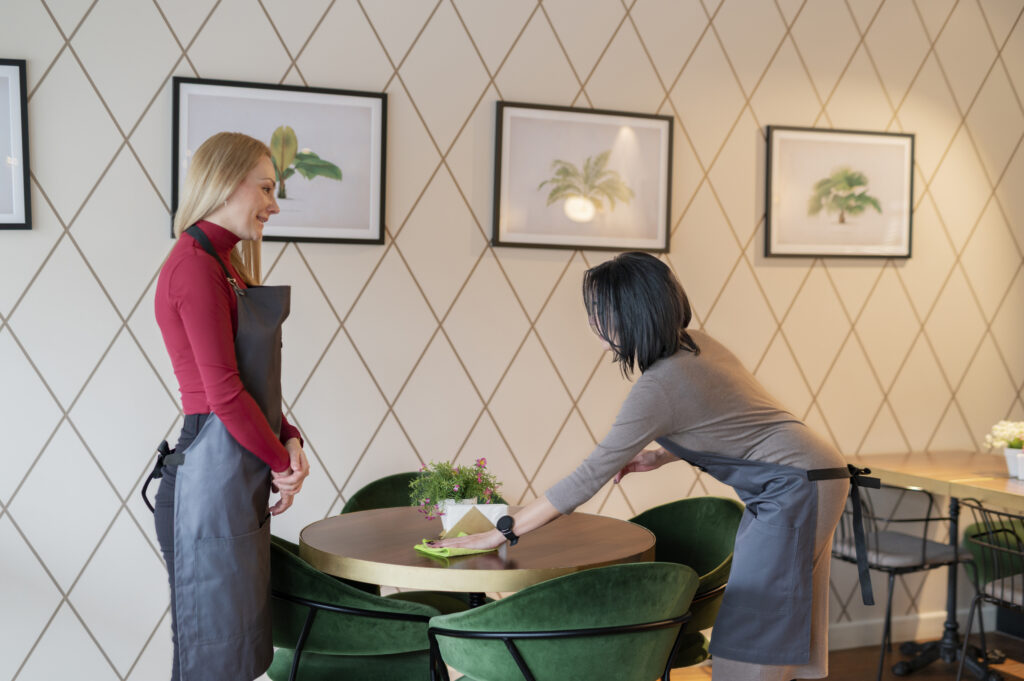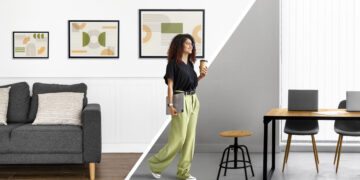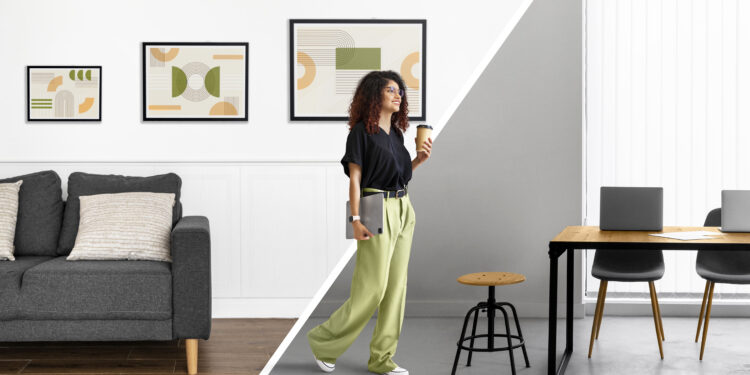Interior design isn’t about chasing trends or buying everything new. It’s about crafting spaces that feel calm, functional, and unmistakably yours. This guide focuses on real homes and real budgets—with seven practical tips you can apply this week. Along the way, you’ll learn key design rules (3-5-7, 70/30, 60/40), the seven foundational principles of design, and simple ways to sharpen your eye. The MintPalDecor approach favors balanced color, smart layouts, honest materials, and thoughtful styling.
The seven basics
Every good room rests on seven fundamentals: space, line, form, light, color, texture, and pattern. Space is both what you fill and what you leave empty; designers balance positive space (furniture, decor) and negative space (breathing room) to keep a room from feeling crowded. Line guides the eye—horizontal lines steady, vertical lines lift, and dynamic diagonals add movement. Form refers to shapes and volumes; mixing curves and straight-edged pieces brings harmony. Light—both natural and artificial—sets mood and ensures function, which is why layering different light sources matters. Color shifts the emotional tone and unifies a scheme. Texture brings depth; smooth against nubby, matte against sheen makes a room feel rich. Pattern adds rhythm and interest when used thoughtfully. These basics are widely taught in design education and aligned with practices championed by professional organizations and historic design principles.
Rules, simply put
What is the 3-5-7 rule in interior design? Group objects in odd numbers—three, five, or seven—because the eye reads odd groupings as more dynamic and balanced. Vary height and shape within the group and repeat at least one unifying element, like a material or color, to keep it cohesive.
What is the 70/30 rule in interior design? Assign roughly 70% of a room to your dominant style and 30% to a complementary style. This prevents a space from feeling theme-heavy or chaotic when you love more than one look. You might go 70% modern lines and neutrals, 30% vintage warmth and patina.
What is the 60/40 rule in interior design? Think of it as a planning ratio. One practical interpretation is 60% for circulation and primary use, 40% for furnishings and feature zones so the room breathes. Another useful interpretation is a color split between main tones and secondary tones. Pick one approach and apply it consistently across your project.
Tip 1: Purpose first
Start with a purpose map for each room. List what really happens there—reading, hosting, working, playtime—and rank those activities. Trace the natural flow: how you enter, where you sit, sightlines to windows or a focal point. Measure the room, noting radiators, outlets, vents, and door swings. Use painter’s tape on the floor to outline potential furniture footprints before buying. This upfront work is how you avoid impulse purchases that don’t fit or serve. Designers do it, not because it’s glamorous, but because function is the backbone of comfort and style.
Tip 2: Choose your style
If you’re unsure how to choose interior design style, start with a mood board of 12–15 images that genuinely resonate. Don’t overthink it—pin rooms you could live in tomorrow. Step back and circle the common threads: recurring colors, materials (like oak, linen, brass), silhouettes (curvy vs. angular), and atmosphere (cozy, airy, grounded). Distill those into three words, like “warm, airy, organic.” These become your filter for every decision. Use the 70/30 rule to blend styles: perhaps 70% airy modern lines, 30% organic textures and handcrafted pieces. MintPalDecor’s lens often leans toward soft palettes, natural fibers, and clean lines balanced with tactile accents.
Tip 3: Make a color plan
A simple color plan keeps you from drifting. Choose one dominant neutral (walls or large pieces), one secondary color for supporting furniture or rugs, and one to two accent colors for pillows, art, or accessories. Test large paint swatches on multiple walls and look at them morning to night—light changes everything. A common distribution is 60/30/10 for color: 60% dominant, 30% secondary, 10% accents. Repeat each accent at least three times across the room to make it feel intentional. If you love bolder hues, anchor them with natural materials—wood, stone, rattan—to ground the palette.
Tip 4: Layout and balance
Lay out your room with zones for conversation, reading, dining, or work. Balance visual weight by not clustering all large pieces on one side. Keep comfortable walkways—about 30 to 36 inches for main paths—and aim for 16 to 18 inches between sofa and coffee table for easy reach. Use the 60/40 guideline for breathing room and furnishings so the space feels open, not cramped. Rugs should sit under the front legs of sofas and chairs at a minimum; in dining rooms, allow about 24 inches beyond the table on all sides so chairs slide back without catching. These measures are standard working dimensions interior designers return to again and again because they simply make rooms feel better to live in.
Tip 5: Layer lighting
Good rooms rarely rely on a single overhead light. Layer three types: ambient (ceiling lights, ceiling wash), task (reading lamps, under-cabinet lights), and accent (sconces, picture lights, spotlights). Warm white bulbs in the 2700–3000K range are comfortable for living spaces; use dimmers wherever possible so one room can shift from bright and active to soft and inviting. Plan for at least three light sources in a living room and two in smaller rooms, adjusting for size. Mirrors and reflective finishes can bounce light deeper into a room, especially helpful in small or north-facing spaces.
Tip 6: Style with odd numbers
Styling is where homes get personality. Use the 3-5-7 rule when arranging decor on shelves, consoles, and nightstands. Combine objects of differing heights—like a lamp, a stack of books, and a small sculpture—and repeat one material to tie them together. Leave negative space so the eye can rest. Group books horizontally and vertically to create rhythm, and let soft items like a linen runner or a ceramic bowl add texture. Rotate pieces seasonally from a small decor stash to keep things fresh without constant buying. Editing is part of styling—remove what doesn’t serve the story of the room.
Tip 7: Texture and pattern
Texture gives depth to even the most neutral palette. Aim for at least three textures: soft (linen, wool, velvet), hard (wood, stone, concrete), and reflective (glass, metal). With pattern, think in scales—one bold pattern, one medium, one subtle—to avoid visual noise. If you love pattern, keep the color palette restrained. Repeat a key material three times around the room, like black metal in a lamp, a frame, and a side table base, to feel intentional rather than random.
how to be better at interior design mintpaldecor

Getting better daily
How to get better at interior design comes down to two habits: training your eye and practicing small. Build a reference folder of rooms you love. Every time you save an image, jot why—maybe “sofa legs show, airy feel,” or “art hung at eye level,” or “mix of woods works.” Weekly, restyle a single surface. Photograph before and after; pictures reveal clutter and balance issues the eye misses in real time. Keep a swap box where decor rotates rather than accumulates. The skill grows with repetition, not with gigantic overhauls.
Decorate like a designer
Professionals follow a repeatable process. Start with a brief: purpose, your three style words, budget, and any must-keep items. Plan the layout with measurements and sightlines, then build your palette. Source anchors first—sofa, rug, bed, dining table—before smaller accents; anchors set tone and scale. Sample finishes together: paint chips next to fabric swatches and wood tones to ensure harmony under your room’s actual lighting. Stage in layers, placing large pieces first, then textiles, then art, then decor. End with an edit: remove one thing from each surface and test the room at night and in daylight.
Budget moves that read high-end
Big impact doesn’t need big spend. Choose fewer, larger art pieces over many small knickknacks to reduce visual clutter. Hang curtains high and wide to make windows feel taller; lined curtains fall better and block light cleanly. Replace builder-grade lighting with a statement fixture or two; scale matters—bigger often looks more tailored. Swap basic hardware for brushed brass, matte black, or aged bronze, and don’t forget switch plates and door stops for a cohesive finish. In the kitchen, new knobs and pulls can transform cabinets. Invest where touch and comfort matter most—sofa, mattress, dining chairs—and save on occasional accents.
Mistakes to avoid
Several common missteps make rooms feel off. Rugs that are too small shrink a space; err larger. Pushing all furniture against walls kills conversation—float pieces to create inviting zones. Buying matching sets flattens personality; mix coordinates within your palette. Neglecting dimmers or buying lamps with shades too small leads to harsh or inadequate light. Overfilling shelves ignores negative space; let your best pieces breathe. And remember scale: a tiny art piece above a large sofa looks lost; size it so the art is roughly two-thirds the width of the furniture below.
Mint Idea House
Imagine a “Mint Idea House” as a guiding thread for choices. The palette: soft sage, warm white, natural oak, with matte black accents. The style blend: 70% calm modern—clean lines, quiet color; 30% organic warmth—textured linens, hand-thrown ceramics, woven baskets. In the living room, seating is anchored on an appropriately sized rug, three light sources create mood, and shelves are styled in odd-number vignettes. In the kitchen, hardware and lighting add character while the main surfaces stay simple. Bedrooms layer breathable textiles for comfort and quiet. Throughout, repeated materials and a restrained palette keep the home connected from room to room.
FAQs
What are the 7 basics of interior design?
Space, line, form, light, color, texture, and pattern. They’re the framework behind every layout and styling choice you make.
What is the 3-5-7 rule in interior design?
Use odd-number groupings when styling and vary heights, shapes, and textures. Include a unifying material or color for cohesion.
What is the 70/30 rule in interior design?
Keep 70% of the space in your primary style and 30% in a complementary style so blending looks intentional.
What is the 60/40 rule in interior design?
Preserve about 60% for circulation and primary use and 40% for furnishings and zones, or apply a 60/40 color split for main and secondary tones. Use one interpretation consistently.
How to improve interior design?
Start with purpose, select a clear style, make a color plan, design the layout for flow, layer lighting, style with odd-number groupings, and build texture. Practice small, edit often, and photograph your progress.
How to choose interior design style?
Mood board what you love, identify common threads, define three style words, and use 70/30 to blend without clutter.
How to decorate like an interior designer?
Follow a process: brief, plan, source anchors, sample finishes together, stage in layers, and edit.
Room quick wins
Living room: Use a rug large enough to ground seating, keep 16 to 18 inches between sofa and coffee table, and style the coffee table in a 3-5-7 vignette. Add a floor lamp behind a chair for task light and a dimmable lamp for evening ambience.
Bedroom: Center the bed on a wall with balanced nightstands and lamps. Layer textures—cotton sheets, a quilt, a wool throw—for depth. Hang art with the center around 57 inches from the floor, a museum standard that tends to feel natural.
Kitchen and dining: Update hardware and add a statement pendant or chandelier sized to the table. Under-cabinet lighting improves both function and mood. Keep stools and dining chairs in finishes that echo materials elsewhere in your home.
Entry: Combine a bench, hooks, and a catchall tray. A mirror expands light and lets you do a last check before heading out. A durable runner in a forgiving pattern hides wear.
Sourcing and materials
Prioritize the pieces you’ll use daily and touch often: sofa frames with sturdy construction, supportive cushions, and durable upholstery; solid wood or quality veneer for tables that take a beating; rugs with fiber content suited to your lifestyle (wool for resilience, blends or washable synthetics for kid- and pet-heavy homes). When mixing woods, keep undertone consistent—warm with warm, cool with cool—or bridge them with a neutral element like black metal. Sample fabrics and finishes together at home because store lighting lies; check them in morning, afternoon, and evening light before committing.
Final edit and upkeep
Before you call a room done, do a 10% removal pass. Take away a handful of items and see if the room breathes better. Live with the space for a week, then adjust lamp placements, art height, or furniture angles. Create a seasonal refresh ritual: swap pillow covers and throw blankets, rotate a few art prints, bring in greenery or branches. Keep a small toolbox handy—felt pads for chair legs, picture-hanging supplies, cable management clips—to preserve polish. Photograph the room every few months; you’ll notice drift and can steer back toward your original three style words.
Conclusion
Improving your home is a steady process, not a one-day overhaul. If you apply these seven practical tips—purpose-first planning, a clear style anchor, a simple color plan, balanced layouts, layered lighting, thoughtful styling, and rich texture—you’ll feel the difference immediately. The rules are there to guide, not constrain: 3-5-7 for styling, 70/30 for blending styles, 60/40 for breathing room or color balance. Start with one room, make a small change this weekend, and build from there. The heart of how to be better at interior design MintPalDecor is consistency: a few well-chosen moves, repeated with care, will give you a home that looks pulled together and feels unmistakably yours.




















































